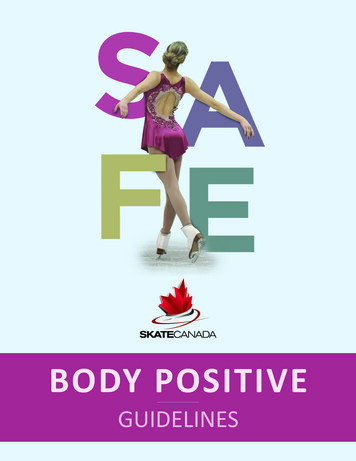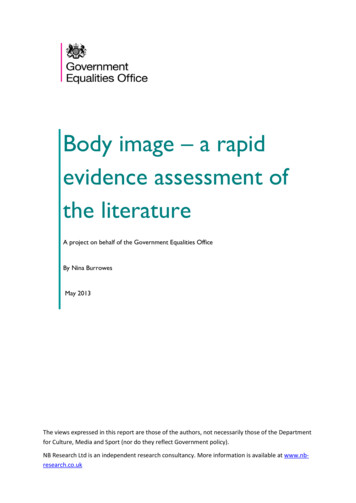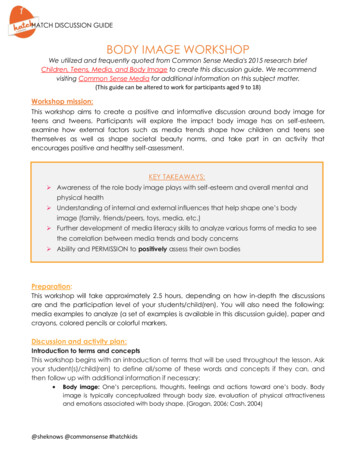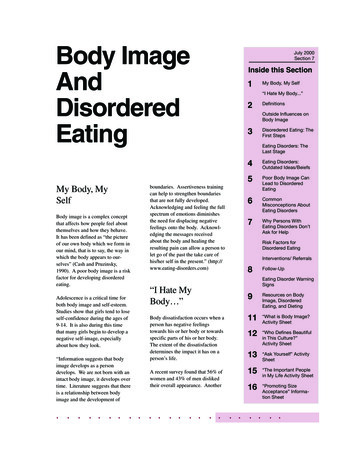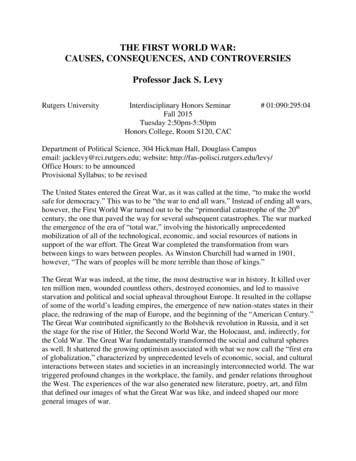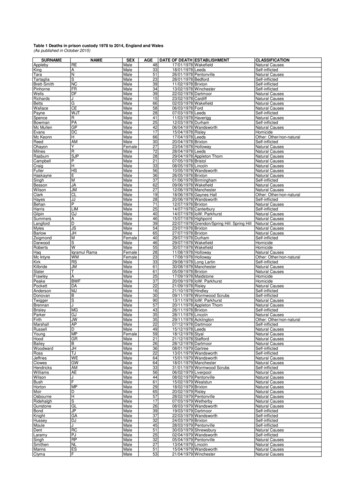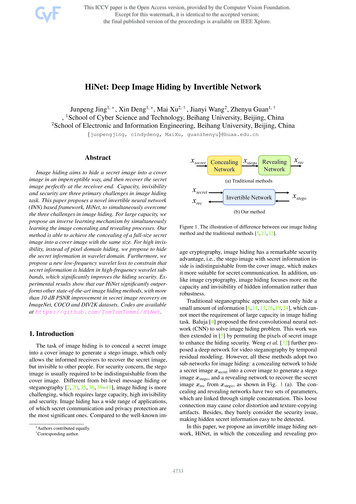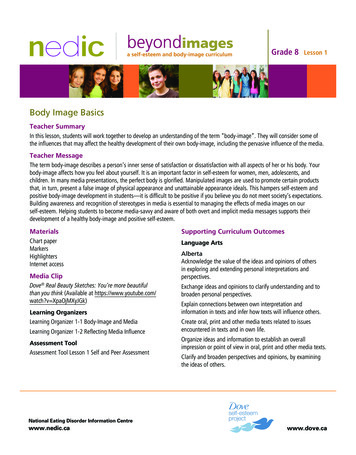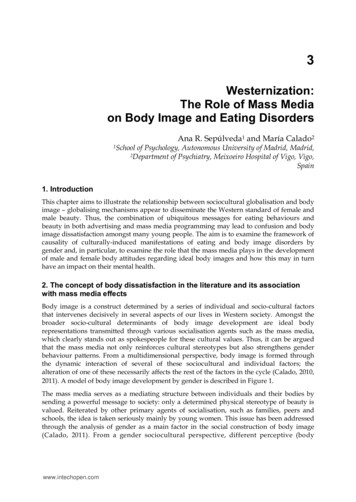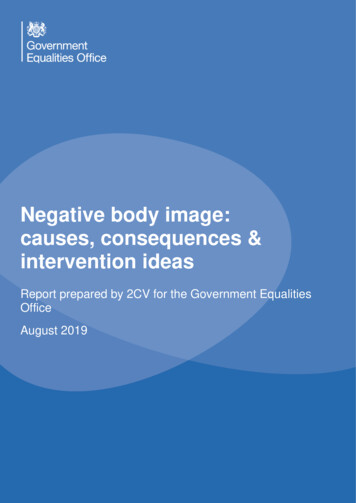
Transcription
Negative body image:causes, consequences &intervention ideasReport prepared by 2CV for the Government EqualitiesOfficeAugust 2019
Document version / Date
Negative body image:causes, consequences & intervention ideasThis research was commissioned under the previousgovernment and before the covid-19 pandemic. As aresult the content may not reflect current governmentpolicy, and the reports do not relate to forthcomingpolicy announcements. The views expressed in thisreport are the authors’ and do not necessarily reflectthose of the government.1
Negative body image:causes, consequences & intervention ideasContentsGlossary:6Executive Summary8Background and Objectives8Methods and Sample8Key Findings and implications81. Introduction131.1Background to the research131.2Methodology141.3 Challenges and recommendations for future research16Chapter 2: Current perceptions of and attitudes towards ‘body image’17Chapter summary: Implications/hypotheses for interventions172.1 Negative body image was recognised as a problem by most participants, and the trendtowards body positivity and body neutrality reflects this.182.2 Our participants recognised that body image hinges on more than just diet and exercise192.3 Despite making links between body image and mental health, many men in our sample(especially heterosexual men) still reported feeling body image was more of a ‘woman’s issue’192.4 There is a perception that boys and men are less empowered to speak out about body imageissues than girls and women, but that they face similar struggles202.5 Many participants linked body image issues to social media, but many felt they were notpersonally affected202.6 Many of our participants also reported feeling body image is strongly linked to social class 21Chapter 3: Setting the Scene: Experiences of body image22Chapter Summary: Implications/hypotheses for interventions223.1. Overarching audience insights233.2 Audience specific insights24Chapter 4: The influences on body image32Chapter Summary: Implications/hypotheses for interventions324.1. The media and brands were found to exert an influence on body image in both our primaryresearch and findings from the REA334.2. Peers and partners play a huge role in influencing body image234
Negative body image:causes, consequences & intervention ideas4.3 Families also play a huge role in influencing body image; relationships between mothers anddaughters play a pivotal role354.4 Our participants reported being influenced by highly visual dating apps like Tinder35Chapter 5. The influence of social media on body image: a complex picture36Chapter summary: Implications/hypotheses for interventions365.1. Though a direct causal relationship is difficult to establish, most researchers agree that theimpact of social media might be more harmful than that of traditional media375.2 The evidence suggests that social media allows for more frequent social comparisons andgreater internalisation of beauty ideals385.3 The REA suggests that thin and fitspiration content on social media may be harmful to users,but our primary research suggests people are increasingly critical of this content395.4 The REA suggests that social media has led to a shift in focus from body image to face, hairand skin comparisons405.5 Time spent on social media (particularly time spent engaging in appearance related activities)and number of Facebook friends have been found to negatively influence body image415.6 Despite the negative impact of social media, researchers have also reported positive impacts,which is supported by first-hand accounts of our participants42Chapter 6: Moving towards interventions446.1. Testing Hypotheses & Moving towards interventions: co-creation and designing interventionprinciples44Chapter 7. Conclusion477. References49Appendix 1: Sample531.1Digital diaries sample531.2 Co-design workshops sample54Appendix 2: Fieldwork Materials & Stimulus552.1 Digital diaries task overview:552.2 Co-design workshops: session flow overview562.3 Co-design workshops: example of information and inspiration booklet56Appendix 3: Challenges and recommendations for future research58Appendix 4: Testing Hypotheses: how did we do it?60Appendix 5: Intervention ideas created by participants in our co-creation workshops65Education ideas:653
Negative body image:causes, consequences & intervention ideasPeer-to-peer/community support ideas:65Mental health ideas:66Physical health ideas:66Social media ideas:664
Negative body image:causes, consequences & intervention ideas5
Negative body image:causes, consequences & intervention ideasGlossary:1Bisexual: Attraction towards more than one gender or sexBody appreciation: Appreciating the ‘features, functionality and health’ of one’s bodyBody image: Body image has been conceptualized as a complex and multi-faceted constructencompassing many aspects of how people experience their own embodiment, especially theirphysical appearanceBody incongruence: The disconnect or ‘incongruence’ between the physical body and theexperienced selfBody neutrality: A Body Image Movement that doesn’t focus on appearance, but insteadencourages individuals to place less importance on their physical bodyBody positivity: A Body Image Movement rooted in the belief that everyone should have apositive body image and challenge the ways in which society presents and conceives of thephysical body. The movement encourages acceptance of all bodies, no matter their size or shapeBody satisfaction: The extent to which an individual is content with their body size and shape.Incorporated into this theme are terms such as body confidence, body esteem, and bodydissatisfactionBody surveillance: The habitual monitoring of how one’s body is perceived by othersCisgender: Refers to individuals whose gender identity matches with the sex assigned to them atbirthFitspiration: A person or ‘thing’ that serves to motivate an individual to sustain or improve theirhealth and fitnessGay: A term used to describe someone who has an emotional, romantic or sexual orientationtowards someone of the same sex or genderGender/body dysphoria: A medical diagnosis that someone is experiencing discomfort ordistress because there is a mismatch between their sex and their gender identity. This issometimes known as gender identity disorder or transsexualism. It is not a mental illnessHeteronormative: The assumption that all people are heterosexual and that heterosexuality isnormal and naturalLesbian: A woman who is attracted to other women. Some lesbians may prefer to identify as gay1Definitions related to gender and sexuality are taken from the Government Equalities Office National LGBT Survey(2019), available online at: l-lgbt-survey-summary-report6
Negative body image:causes, consequences & intervention ideasLGBT: An abbreviation used to refer to lesbian, gay, bisexual and trans peopleNon-binary: People who self-identify as non-binary, gender fluid, agender, non-gender, orgenderqueerSelf-objectification: The phenomenon that occurs when people come to view themselves andtheir bodies as ‘objects to be looked at’7
Negative body image:causes, consequences & intervention ideasExecutive SummaryBackground and ObjectivesBody image, and more specifically body satisfaction, is one of the many factors that impactpeople’s decision making and confidence. As such, body dissatisfaction has been identified as anissue of growing concern to young people and their parents2 and was identified by the BritishYouth Council (2017) 3 as an issue that warrants urgent attention and further research. TheGovernment Equalities Office (GEO) has commissioned research into this area as there isevidence that body image may not only influence individual confidence and aspiration, but mayalso be one of the ‘invisible factors’ that contributes to the Gender Pay Gap. Specifically, thisresearch aims to address the two following questions:1.What impact has the increased use of social media and edited images had on negative bodyimage?2.How does negative body image impact different demographics (including men and boys,ethnic minority audiences, LGBT audiences)?Methods and SampleThis report presents the results of two parts of this project, a rapid evidence review and primaryqualitative research. The evidence review synthesised findings from over 60 academic publishedsources. The primary research sample totalled 46 participants and included a mix of private ‘digitaldiary’ tasks and co-design workshops to test hypotheses and design potential policy interventionswith the public.This report blends the findings from the academic literature with the voices of a wide range ofdifferent groups represented in our primary research, including girls and boys, men and women(age range 15-35 years), LGBT and ethnic minority audiences.Full details of method and sample can be found in Chapter 1.2.Key Findings and implications 2Interventions aimed at tackling [negative/poor] body image are likely to be welcomed.Negative body image was recognised as a ‘problem’ that warrants attention by most of theAll Party Parliamentary Group on Body Image (2012) “Reflections on Body Image”, available online at: British Youth Council (2017) “A Body Confident Future”, available online at: outh-SelectCommittee-A-Body-Confident-Future.pdf8
Negative body image:causes, consequences & intervention ideasparticipants in our primary research and many were aware and supportive of the trendtowards body positivity and body neutrality. Interventions need to take a holistic approach to tackling body image. Body image isabout more than just the physical body and many factors, such as cultural and societal norms,mental health, peer-to-peer dynamics, families and mass media, play an important role inshaping it.4 5 As such, any interventions will need to take a holistic approach, tackling theissue from multiple angles. Interventions should be mindful that experiences of body image vary amongst differentgroups, and change over time. Gender, ethnicity and sexual orientation all play a role inhow people experience body image. The way people experience body image also varies overtime as societal beauty standards change. Interventions may need to be targeted at specific life milestones rather than justparticular age groups. Both the evidence review and our primary research suggest bodyimage impacts behaviour and decision making on a day-to-day basis and throughout people’slives.6 While adolescence is a particularly challenging time for most people,7 our primaryresearch suggests body image is not experienced as a ‘linear journey’. Life events andmilestones (e.g. having a child, going through a divorce) can play an important role in shapingbody image Interventions should encourage a shift in focus from the aesthetics of the body to itsfunctionality, particularly for women. Findings from the evidence review suggest thatwomen8 are particularly affected by negative body image, as they tend to spend more timeengaged in taking and circulating photographs; have lower body ‘appreciation’ than men; andexperience more pressure to look youthful.9 10 11 12 Men may need to be eased into the conversation about body image throughinterventions which encourage them to feel they have ‘permission’ to discuss theissue. Overall, the heterosexual men in our sample felt more distant from the issue, feeling itwas more of a ‘woman’s issue’. However, boys and men in our sample also discussed feelingless empowered to speak out about body image than girls and women, suggesting they mayin fact face similar struggles but feel less comfortable talking about them.4Festinger, L. (1954). A theory of social comparison processes. Human Relations, 7,5Slater, Amy & Tiggemann, Marika & Hawkins, Kimberley & Werchon, Douglas. (2012). Just One Click: A Content Analysis of Advertisements onTeen Web Sites. The Journal of adolescent health: official publication of the Society for Adolescent Medicine. 50.6Girlguiding (2019). acy-and-campaigns/research/girls-attitudes-survey/ ‘Girls’ Attitudes Survey’7Tiggemann, M. Slater, A. (2013). Selfie-Esteem: The Relationship Between Body Dissatisfaction and Social Media in Adolescent and YoungWomen8Note: research does not include trans women9Body Image – A Rapid Evidence Assessment of the Literature” – Government Equalities Office, 2013. Available online ly, Y. Zilanawala, A, Booker, C. Sacker, A. (2018). Social Media Use and Adolescent Mental Health: Findings From the UK Millennium CohortStudy11Andrew, Rachel & Tiggemann, Marika & Clark, Levina. (2015). Can body appreciation protect against media-induced body dissatisfaction?.Journal of Eating Disorders.12Tiggemann, Marika & McCourt, Alice. (2013). Body appreciation in adult women: Relationships with age and body satisfaction. Body image9
Negative body image:causes, consequences & intervention ideas Different support/interventions may need to be considered for LGBT individuals, as theevidence indicates that their experiences tend to be very different to those of cisgenderheterosexual individuals. Likewise, interventions should be mindful of the variation inexperience within the LGBT community. The picture is slightly different for LGBT groups.Findings from the evidence review suggest that: Overall, gay men tend to have lower body satisfaction than heterosexual men.13 Lesbian and bisexual women tend to face different body image pressures andchallenges. However, on the whole, the evidence suggests that they experience greaterbody satisfaction than heterosexual women.14 Trans men and trans women tend to experience lower body satisfaction than theircisgender counterparts – largely due to the incongruence these individuals experiencebetween their physical body and their experienced gender identity.15 Both trans men and trans women report higher degrees of body dissatisfaction,accompanied by disturbed eating patterns, a greater drive for thinness and increasedbody surveillance.16 Non-binary individuals tend to have higher body satisfaction than binary trans individuals.However, they still experience greater dissatisfaction than cisgender individuals. Theevidence suggests that this is likely associated with the ‘social isolation’ that canaccompany being excluded from binary gender and language systems.17 Special attention should be paid to individuals who may experience social disadvantageon ‘multiple levels’. Overall, individuals who may experience social disadvantage on ‘multiplelevels’ (e.g. a gay black woman) are more likely to experience body dissatisfaction. This islinked to their stigmatised status in society, which puts them under more stress, whichincreases their risk of depression and body dissatisfaction.18 It is important for brands and advertising aiming to promote body positivity to be trulyinclusive. Our primary research, particularly amongst LGBT and non-binary audiences,indicates that brands are not doing enough to be inclusive of these audiences. Our non-binaryand trans participants in particular felt that brands could do more to show the huge variability13Morrison, Melanie & Morrison, Todd & Sager, Cheryl-Lee. (2004). Does body satisfaction differ between gay men and lesbian women andheterosexual men and women? A meta-analytic review. Body image.14Alvy LM (2013). Do lesbian women have a better body image? Comparisons with heterosexual women and model of lesbian-specific factors.15Jones, BA., Haycraft, E., Murjan, S. & Arcelus, J. (2016). Body dissatisfaction and disordered eating in trans people: A systematic review of theliterature16De Vries, A. L. C., Mcguire, J. K., Steensma, T. D., Eva, C. F., Doreleijers, T. A. H., & Cohen-Kettenis, P. T. (2014). Young adult psychologicaloutcome after puberty suppression and gender reassignment. Paediatrics, 134, 1–9.17Rimes, K. A., Goodship, N., Ussher, G., Baker, D., & West, E. (2017). Non-binary and binary trans gender youth: Comparison of mental health,self-harm, suicidality, substance use and victimization experiences. International Journal of Trans genderism.18Meyer Ilan H. Prejudice, Social Stress, and Mental Health in Lesbian, Gay, and Bisexual Populations: Conceptual Issues and ResearchEvidence. Psychology of Sexual Orientation and Gender Diversity. 2013;1:3–2610
Negative body image:causes, consequences & intervention ideasof bodily expression that exists within the umbrella ‘LGBT’. It is crucial for any initiative promoting positive body image through health and exerciseto be accessible (and affordable) for everyone. Many of our participants made linksbetween body image, standards of beauty and social class. They felt that body size and bodyshape are often used as shortcuts to determine someone’s social class and that the standardsset by brands and the media are unattainable for most of the population. The effect on body image of new media such as highly visual dating apps also needs tobe considered, but requires further research. The limited evidence available suggests thathighly visual dating apps like Tinder can have a negative impact on self-esteem and bodydissatisfaction and provide another avenue for users to make social comparisons. 19 The specific elements of social media that are problematic may need to beindependently addressed when designing interventions. For example, the potential socialmedia creates for upward comparisons to peers, celebrities, and ‘past selves’ may beparticularly problematic. Specific behaviours associated with social media have also beenidentified as leading to body dissatisfaction, including time spent on social media, number ofFacebook friends, or time spent engaging in photo-based activities. 20 21 22 Interventions may also need to consider ways of identifying users who may beparticularly vulnerable to the negative effects of social media on body image. Noteveryone is affected by social media in the same way or to the same extent. These individualdifferences must be taken into account when targeting and prioritising audiences. The way ‘thinspiration’ and ‘fitspiration’ content is uploaded and shared may need to beconsidered, to avoid spreading inaccurate information. The evidence review findingssuggest that ‘thinspiration’ and ‘fitspiration’ content may be harmful to users due to theproliferation of thin-ideal imagery, unhealthy and unrealistic practices, as well as inaccurateinformation. 23 24 25 The increased attention to face, hair and skin suggests that interventions may need totake into consideration more than just body shape and size. The evidence review19Strubel, Jessica & Petrie, Trent. (2017). Love me Tinder: Body image and psychosocial functioning among men and women. Body Image.20Holland, G. Tiggemann, M. (2016). A systematic review of the impact of the use of social networking sites on body image and disordered eatingoutcomes.21Fardouly, J. Diedrichs, P. Vartanian, L. Halliwell, E. (2014). .The impact of Facebook on young women's body image concerns and mood.22Rutledge,C.M.,Gillmor,K.L.,& Gillen, M.M.(2013).Does this profile picture make me look fat? Facebook and body image in college students .Psychology of Popular Media Culture,2,251–258.23Eysenbach, G. (2013). Misleading Health-Related Information Promoted Through Video-Based Social Media: Anorexia on YouTube24Tiggemann, Marika & Zaccardo, Mia. (2015). “Exercise to be fit, not skinny”: The effect of fitspiration imagery on women's body image. Bodyimage.25Ibid11
Negative body image:causes, consequences & intervention ideassuggests that social media has led to a shift in focus from body image to face, hair and skincomparisons due to portrait-style photography it encourages. 26The issues explored in this report are complex and multi-faceted. The findings presented areintended to provide a useful knowledge foundation, which we hope will create dialogue and bothinspire and create a framework for further research.26Haferkamp, Nina & Krämer, Nicole. (2010). Social Comparison 2.0: Examining the Effects of Online Profiles on Social-Networking Sites.Cyberpsychology, behavior and social networking. 14.12
Negative body image:causes, consequences & intervention ideas1. Introduction1.1 Background to the researchThe Government Equalities Office (GEO) leads work on policy relating to women, sexualorientation, and trans gender equality, and is responsible for a range of equalities legislation. It isestimated that 35% of the gender pay gap is attributed to unobserved factors - things not readilycaptured in data - but which are likely to include gender stereotypes and discrimination againstwomen27. GEO is commissioning research to explore what more government, schools, parentsand individuals can do to help reduce harmful stereotypes, attitudes and behaviours.Body image, and more specifically, body dissatisfaction is one of the many factors that impactspeople’s decision making and confidence. Body dissatisfaction has been identified as an issue ofgrowing concern to young people and their parents,28 and was identified by the British YouthCouncil (2017) as an issue that warrants urgent attention and further research to fill theknowledge gaps. GEO committed to addressing these gaps in their recent response to the YouthSelect Committee report on Body Confidence.29GEO commissioned a Rapid Evidence Assessment (REA) synthesising the evidence on thecauses and consequences of negative body image in 2013.30 The review identified potentialcauses of negative body image, such as being overweight or obese; viewing media images ofideal body shapes; the influence of family and peers as well as individual psychological factorssuch as the tendency to compare against others. It also identified potential consequences, suchas low self-esteem, depression, and the use of unhealthy weight control behaviours. The reviewconcluded that women tend to be most impacted by negative body image compared to men,regardless of age or ethnicity.31While this review identified some of the key causes and consequences of negative body image,the landscape has changed significantly since 2013, and the evidence required updating.Specifically, two new areas of interest needed to be investigated: What impact has the increased use of social media and edited images had on negative bodyimage? How does negative body image impact different demographics (for example, men and boys,ethnic minority audiences, LGBT audiences)?27Olsen, W., Gash, V. Kim, S., Zhang, M. (2018). The Gender pay gap in the UK: evidence from the UKHLS.28All Party Parliamentary Group on Body Image (2012) “Reflections on Body Image”, available online at: 9British Youth Council (2017) “A Body Confident Future”, available online at: Burrowes, N. (2013) “Body image – a rapid evidence assessment of the literature”, available online ment/uploads/system/uploads/attachment data/file/202946/120715 RAE on body image final.pdf31ibid13
Negative body image:causes, consequences & intervention ideasGEO commissioned research agency 2CV to answer these two questions using a multi-methodapproach, combining both primary and secondary research methods. This report blends findingsfrom all three phases of research, as detailed below.1.2 Methodology2CV (henceforth referred to as ‘we’) took a three-phased approach, with findings from each phasefeeding into subsequent phases.1.Rapid Evidence Assessment (REA): We conducted a review of the academic evidence andsynthesised findings from over 60 academic published sources investigating the relationshipbetween social media and body image and the impact of body image on differentdemographics. The REA built on a review previously commissioned by GEO 32 that exploredthe causes and consequences of negative body image. We replicated the search terms usedin the previous review: “body image” or “body confidence” or “body satisfaction” or “bodydissatisfaction” or “body esteem” with the additional search criteria of “social media” and/or“LGBT/ethnic minority audiences”. Databases included Google Scholar, JSTOR and ScienceDirect. Studies were included if they were published in or after 2013; investigated therelationship between social media, body image, body confidence, mental health andpsychosocial outcomes; or if they investigated the impact of negative body image on differentdemographics. The findings from this review form their own output but have been included inBurrowes, N. (2013) “Body image – a rapid evidence assessment of the literature”, available online ment/uploads/system/uploads/attachment data/file/202946/120715 RAE on body image final.pdf3214
Negative body image:causes, consequences & intervention ideasthis report as additional evidence to support our primary research findings with the public, oras sole evidence where our primary research was unable to gather enough audience-specificinsights as a result of sample size limitations.2.Digital diaries with participants: We conducted a one-week digital community with 30participants to deliver an in-depth understanding of people’s attitudes, experiences andbehaviours regarding body image. Participants were given a range of private creative tasks tounderstand their relationships with their bodies, how this has changed over time and whatinfluences this (see Appendix 2.1 for a full break-down of the tasks). Participants wererecruited from across the UK; were aged 15-45; and included a range of demographicsincluding LGBT and ethnic minority representation (see Appendix 1.1 for a full sample breakdown). It is worth noting that while our sample included LGBT and ethnic minorityrepresentation, sample sizes for these audiences were small and we thus refrain fromdrawing any audience-specific insights, unless our findings were backed up by the academicliterature synthesised in the REA.Importantly, we recruited people to have a ‘mix’ of attitudes and feelings towards their bodiesusing elements of the Body Esteem Scale33 and the Body Shape Satisfaction Scale.34 Weexcluded anyone who felt overly positive about their bodies, focusing on those who weremore vulnerable to feeling negatively about themselves, to better understand the factors thatdrive this feeling.3.Stop & Think: We held a workshop with GEO to share findings from the first two phases andused these to generate ideas and hypotheses to test in the subsequent phase: the creativeco-design workshops. The REA allowed us to gather evidence from the academic literatureand gain a theoretical understanding of the issues, while the digital phase allowed us tounderstand people’s lived experiences.4.Creative co-design workshops with participants: We conducted two half-day workshopswith men and women aged 20-40 in London (all were cisgender, heterosexual men andwomen) who were recruited to have a mix of attitudes towards their own body image (rangingfrom more positive to more negative, screening out anyone who had ‘extreme views’ in eitherdirection (i.e. they felt extremely positive or extremely negative) to ensure views expressedreflected those of the ‘general population’). These intervention-focused workshops put thehypotheses and ideas generated in the REA and digital diaries in front of participants tovalidate, critique, finesse and build upon. While LGBT audiences were included in the digitalphase, we did not feel it was appropriate to include a mix of audiences in the face-to-faceworkshops, as the body image experiences of LGBT audiences tend to be so different tothose of cisgender heterosexual people, potentially making a workshop dynamicuncomfortable and unproductive. We thus decided to run two workshops with a morehomogenous sample of men and women who identified as heterosexual. Though our33Franzoi, S. & Shields, S. (1984). The body esteem scale: Multidimensional structure and sex differences in a college population, Journal ofPersonality Development, 48(2), 173-178.34Slade, P., Dewey, M., Newton, T., Brodie, D., & Kiemle, G. (1990). Development and preliminary validation of the body satisfaction scale (BSS),Psychology and Health, 4(3), 213-220.15
Negative body image:causes, consequences & intervention ideasworkshops did include a mix of ethnicities, we did not focus in depth on the differentexperiences of these ethnicities specifically in the workshops.1.3 Challenges and recommendations for future researchWhile this research explored ‘body image’ from multiple angles with a diverse sample, budgetaryconstraints meant we had to make some pragmatic choices about the sample that the readershould bear in mind when reading this report. This research also identified some key gaps in theacademic literature that we recommend should be addressed in future research. We summarisethe limitations of this research and our recommendations below. Full details of challenges andrecommendations can be found in Appendix 3. We found little evidence on the impact of social media on a broad range ofdemographics.Building on this research, future research should continue to focus on investigating therelationship between social media and body image among a wider range of audiences,including ethnic minority groups, LGBT groups and people with disabilities. This isespecially important given the lack of academic research in this space. There is also little evidence on how body image is experienced by differentdemographics and minority audiences in the academ
Negative body image: causes, consequences & intervention ideas 6 Glossary:1 Bisexual: Attraction towards more than one gender or sex Body appreciation: Appreciating the ‘features, functionality and health’ of one’s body Body image: Body image has been conceptualized as a complex and multi-faceted const
